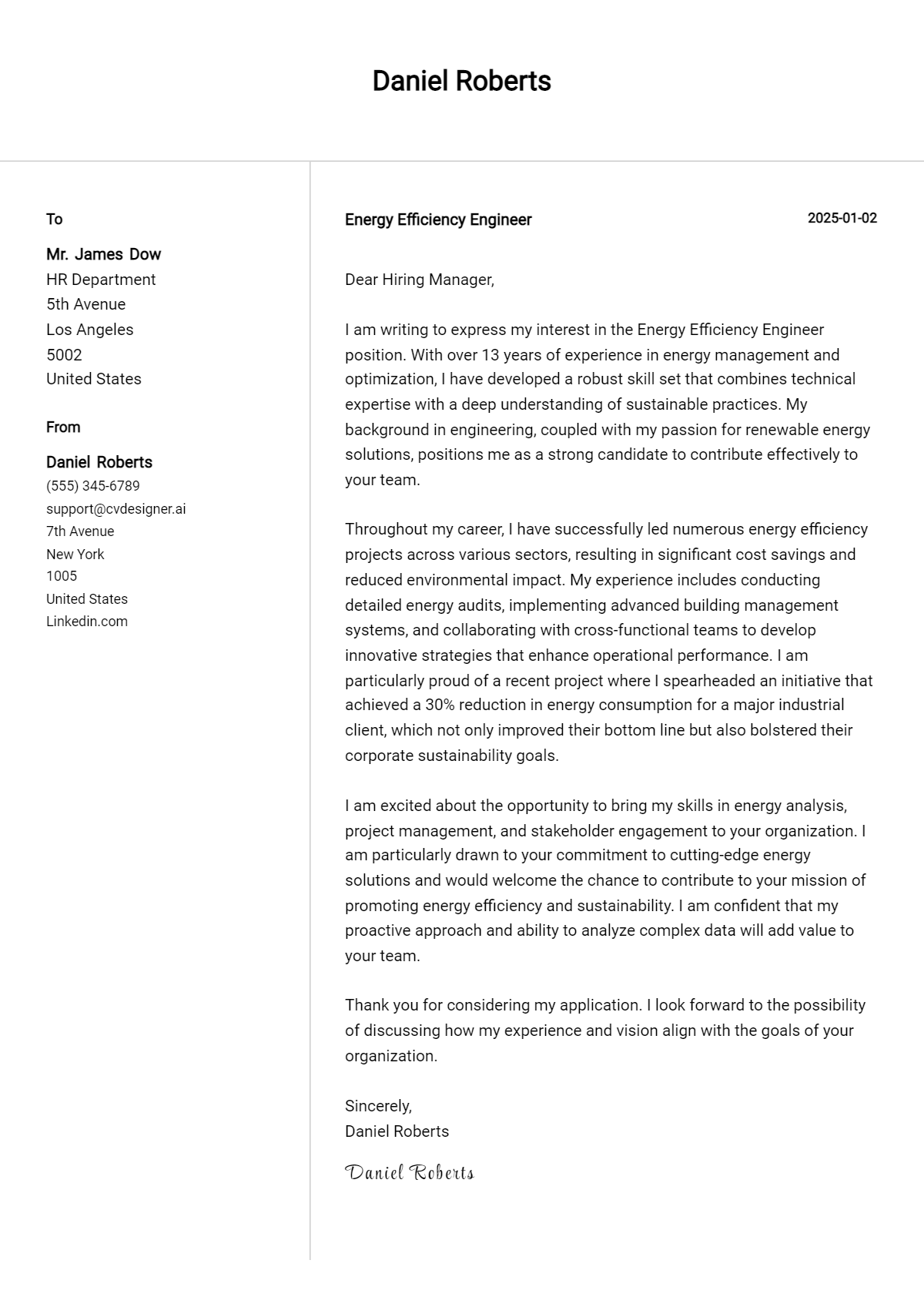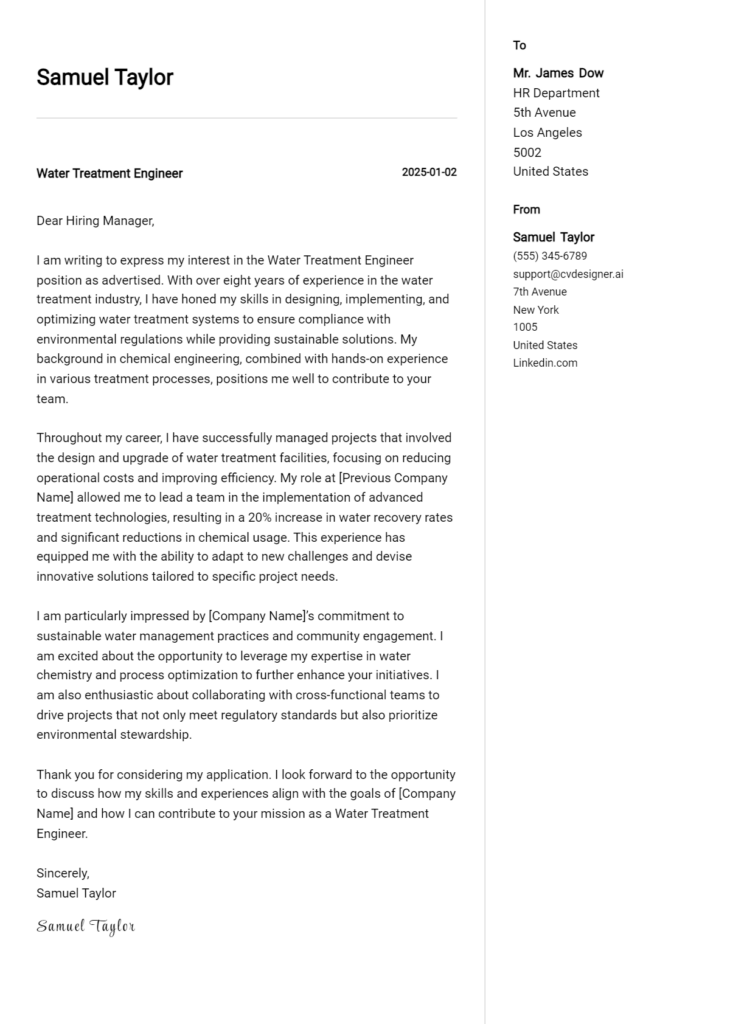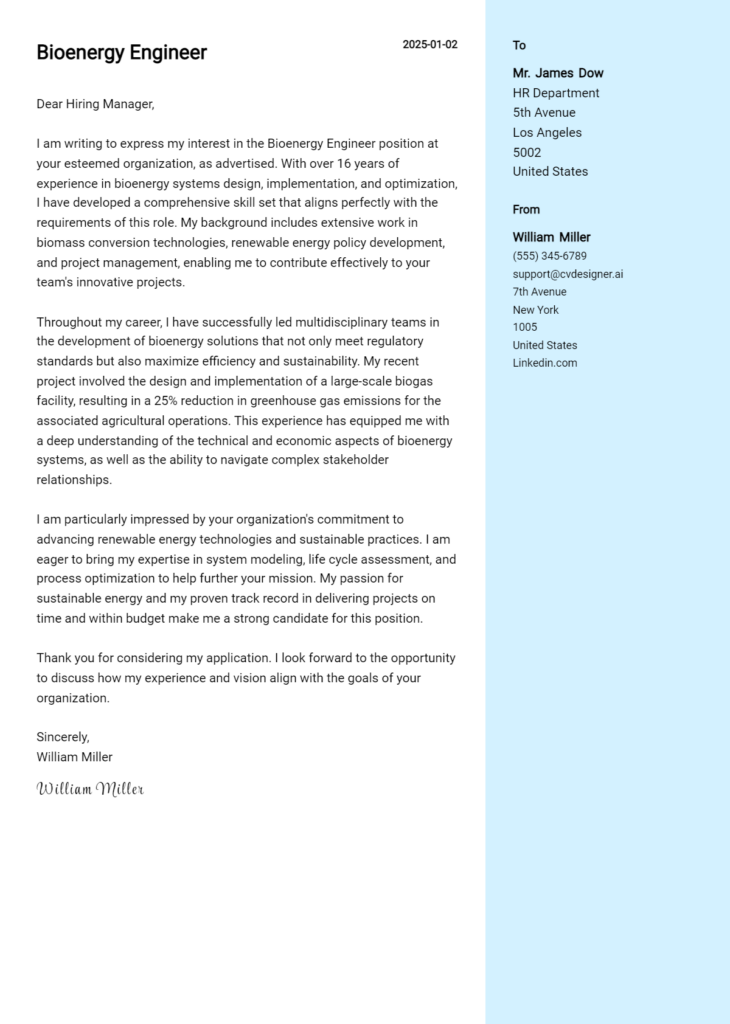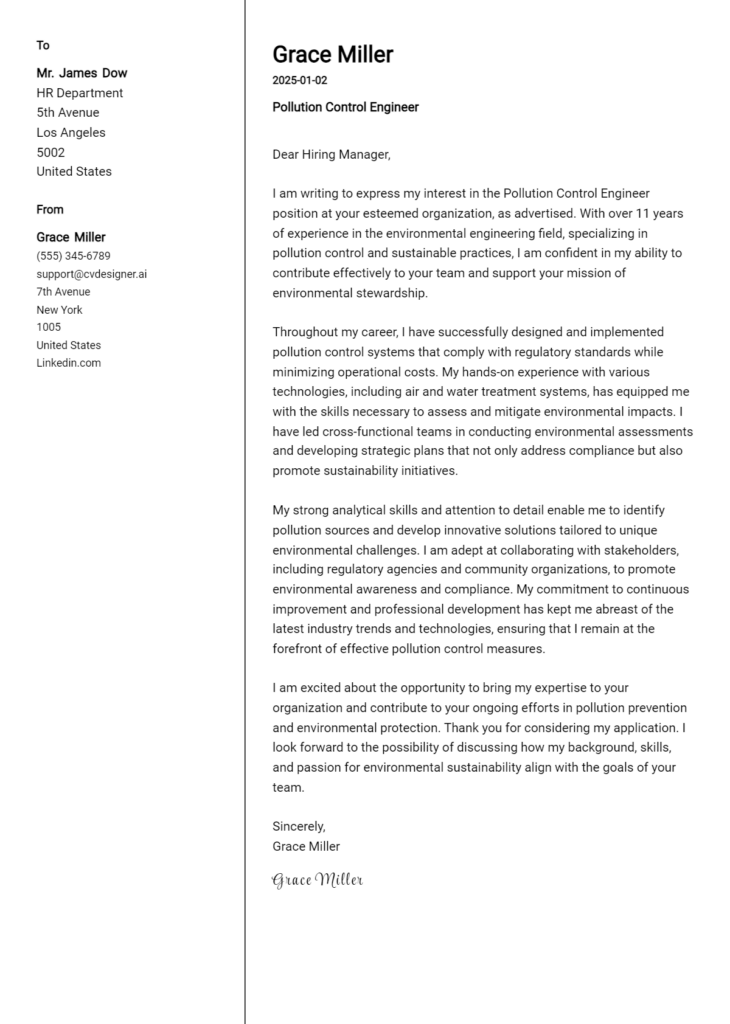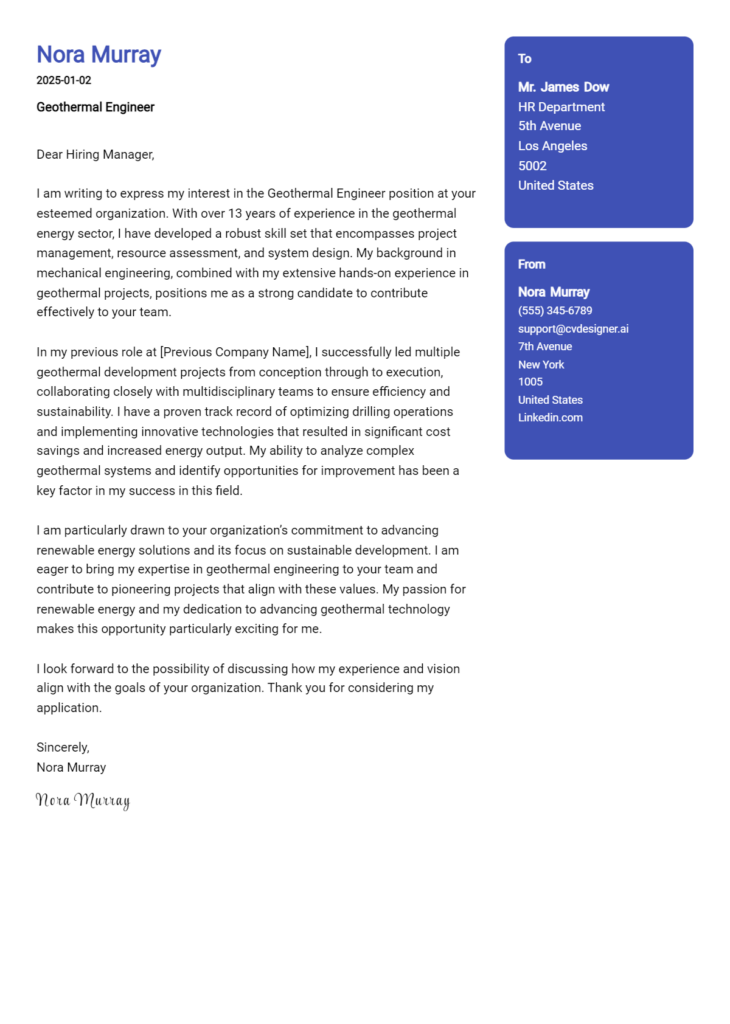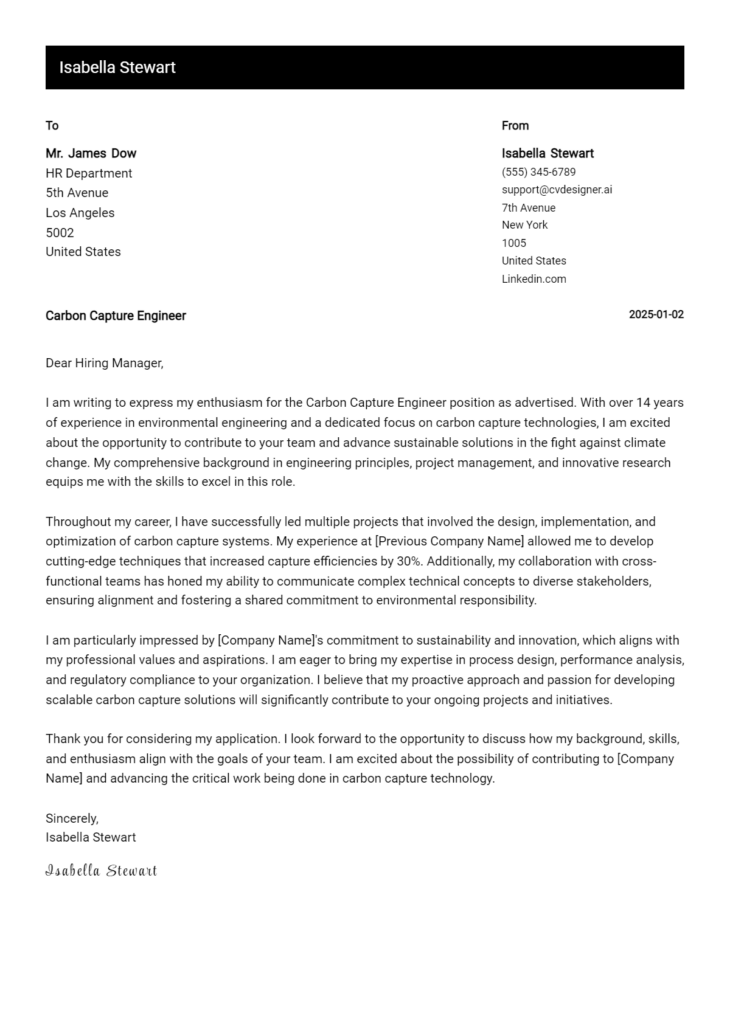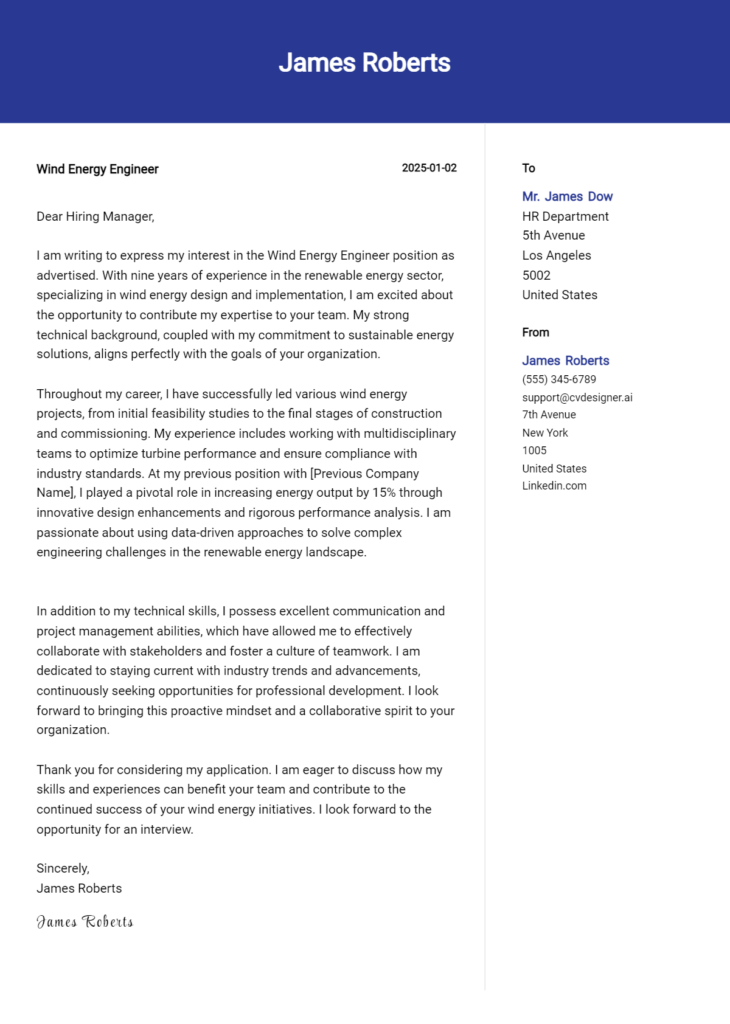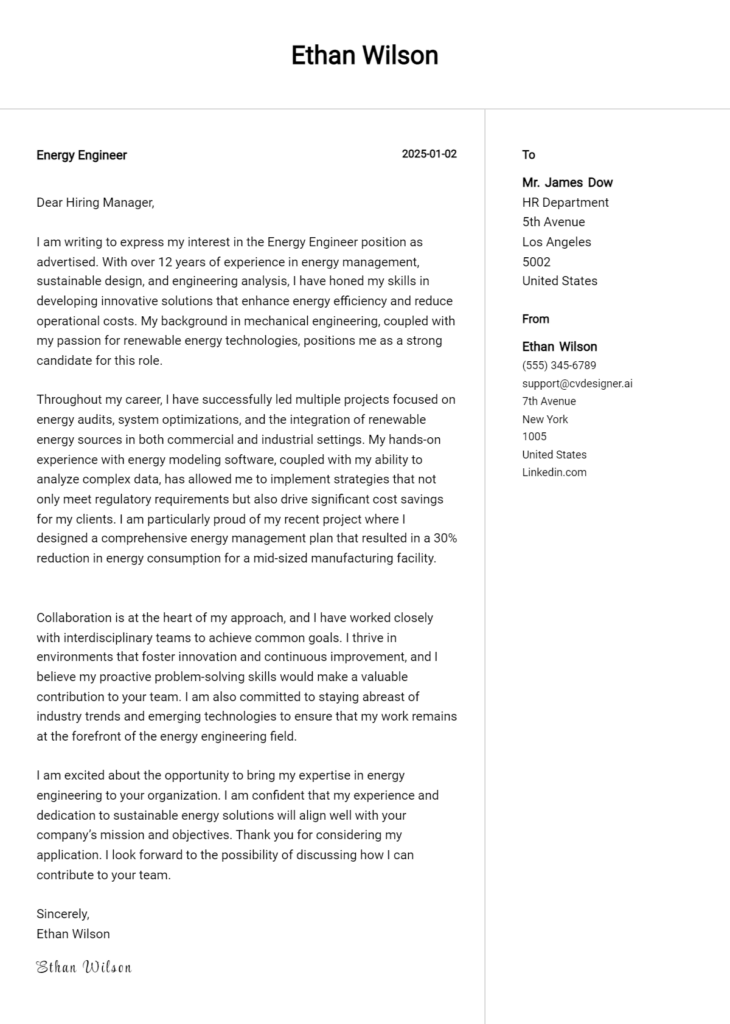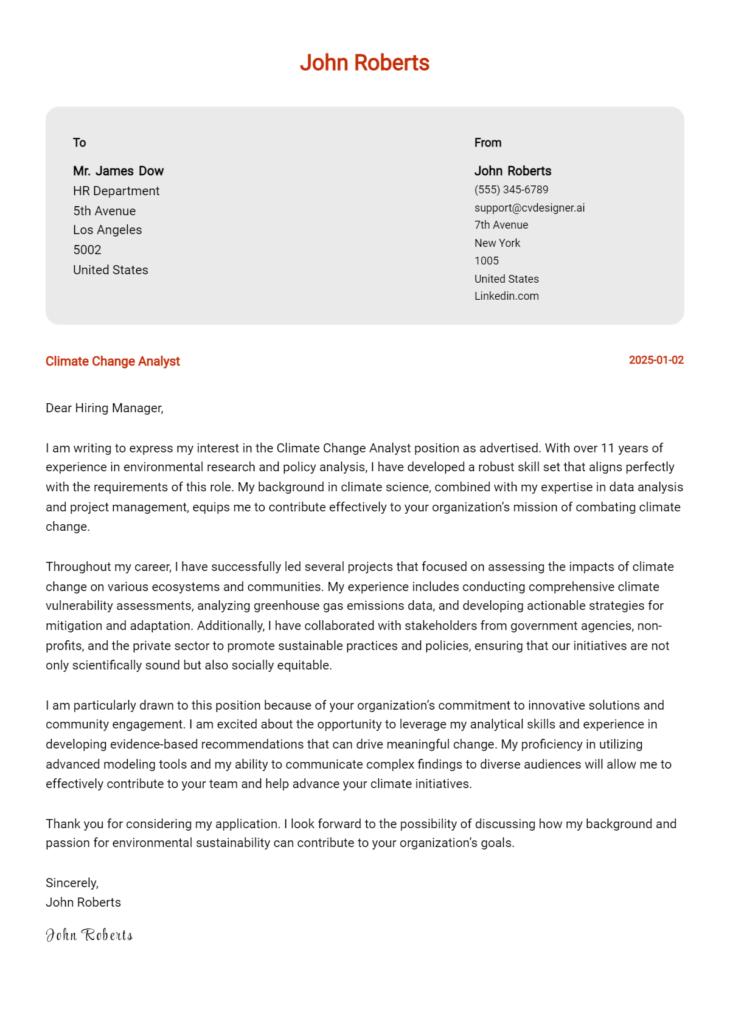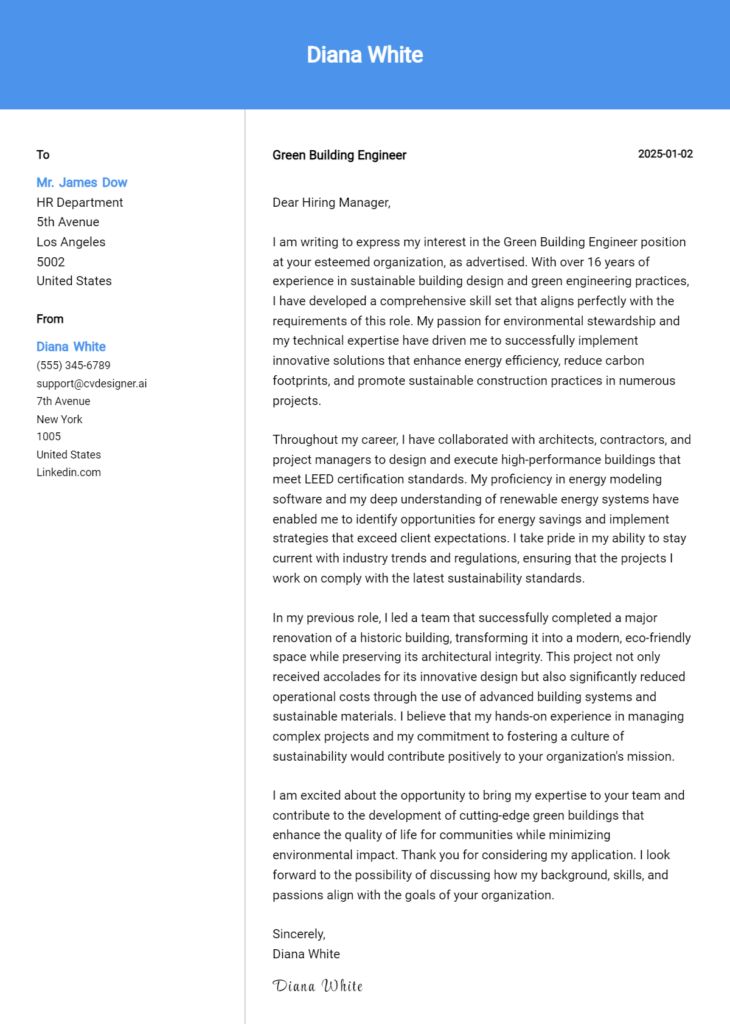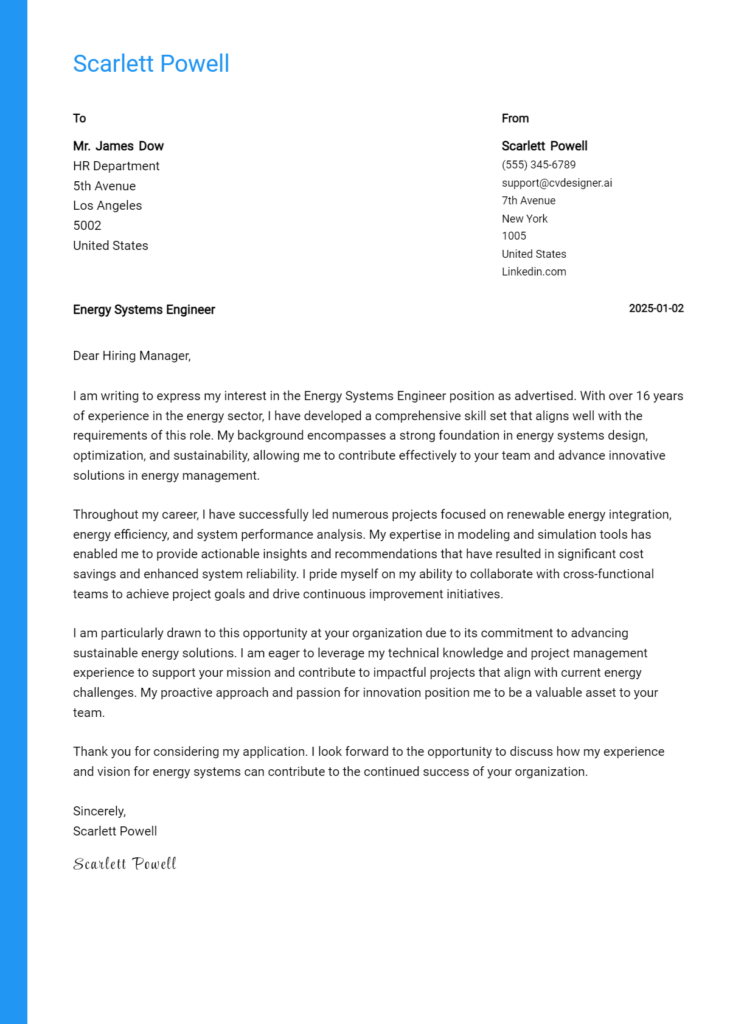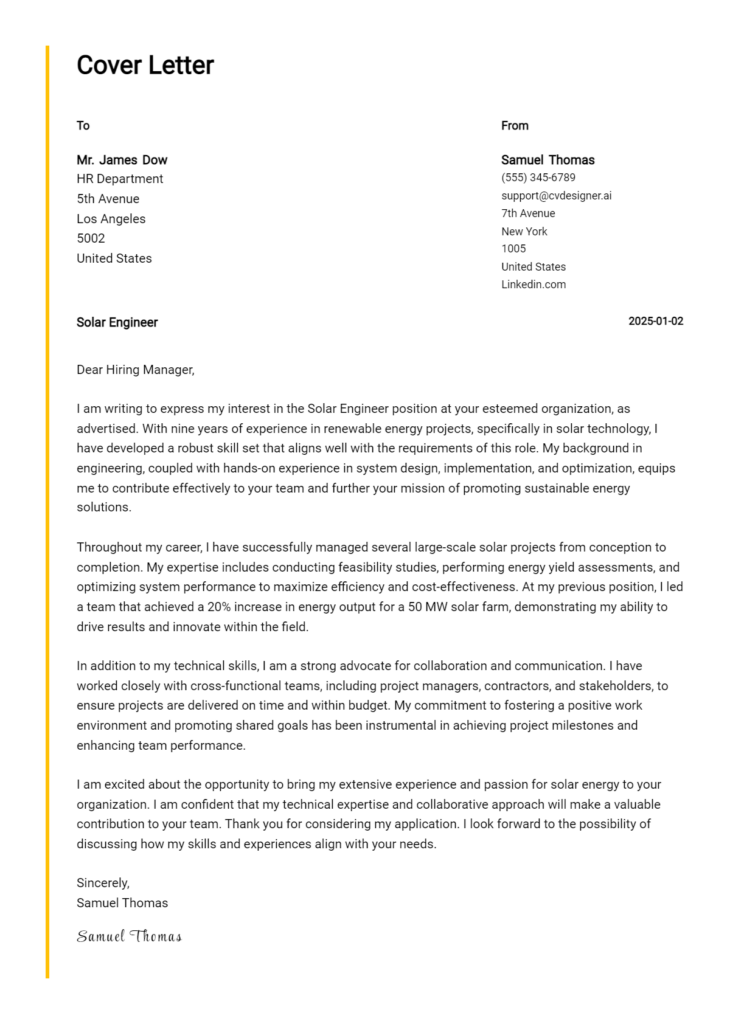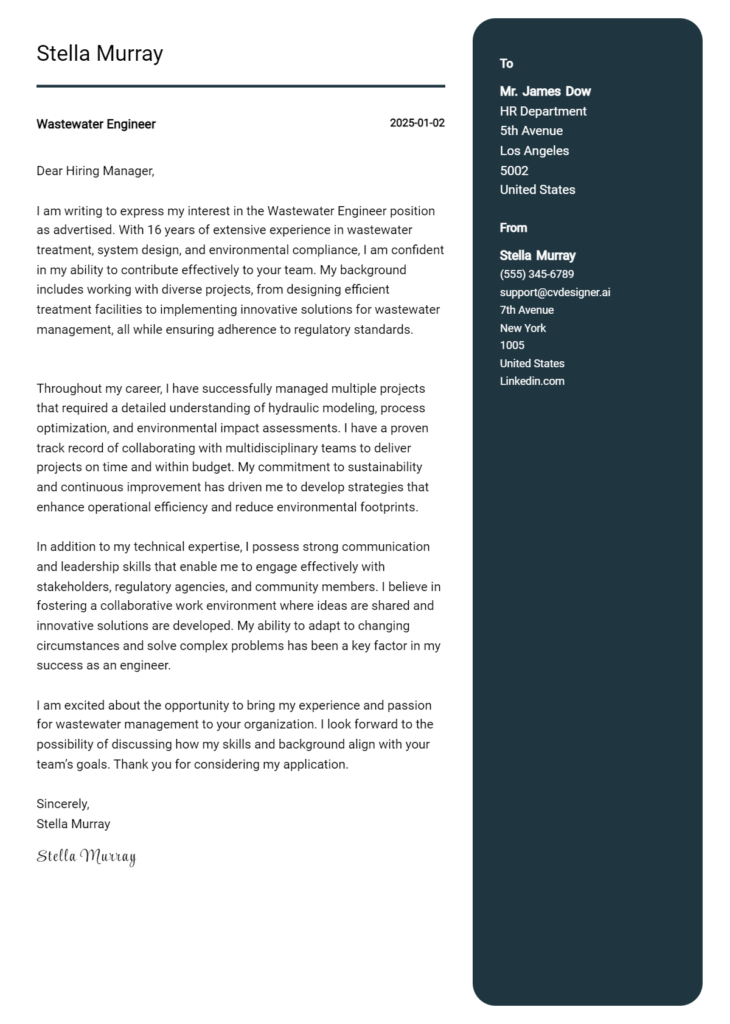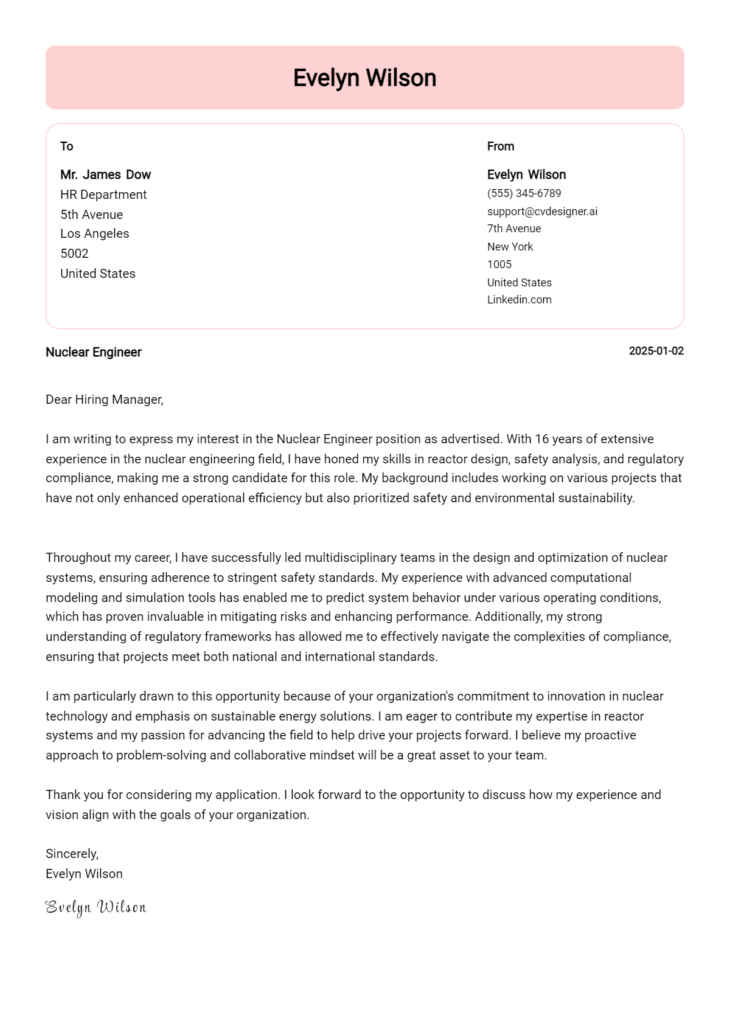Energy Efficiency Engineer Cover Letter Examples
Explore additional Energy Efficiency Engineer cover letter samples and guides and see what works for your level of experience or role.
How to Format an Energy Efficiency Engineer Cover Letter?
Crafting a compelling cover letter is essential for Energy Efficiency Engineers, as it serves as your first opportunity to demonstrate your expertise and commitment to sustainability. The way you format and present your cover letter not only reflects your technical skills but also showcases your ability to communicate effectively—an important trait in the energy sector.
In this guide, we will outline how to structure your cover letter to make a positive impression on hiring managers. By following our recommendations, you will be better equipped to highlight your qualifications and passion for energy efficiency.
We’ll focus on the essential components of a professional cover letter, including:
- Cover Letter Header
- Cover Letter Greeting
- Cover Letter Introduction
- Cover Letter Body
- Cover Letter Closing
Each section is crucial in conveying your professionalism and suitability for the role. Let’s delve into each part and explore how to make your Energy Efficiency Engineer cover letter stand out.
Importance of the Cover Letter Header for an Energy Efficiency Engineer
The cover letter header is a critical component for any job application, including for an Energy Efficiency Engineer. It serves as the first impression and sets the tone for the rest of the document. A well-organized header should include your contact information, the date, and the recipient's details. Clarity and professionalism are essential, as they reflect your attention to detail and respect for the hiring process. A strong header can help you stand out in a competitive job market, while a weak one may create a negative impression right from the start.
Strong Cover Letter Header Example
John Doe 123 Greenway Lane Eco City, ST 12345 (555) 123-4567 johndoe@email.com October 10, 2023 Hiring Manager ABC Energy Solutions 456 Renewable Road Sustainable Town, ST 67890
Weak Cover Letter Header Example
John D. 123 Lane City, ST 555-1234 jd@email 10/10/23 To Whom It May Concern Company Name Street Address
The Importance of a Cover Letter Greeting for an Energy Efficiency Engineer
The greeting of a cover letter serves as the first impression to the hiring manager and sets the tone for the rest of the letter. A well-crafted greeting demonstrates professionalism and shows that you have taken the time to personalize your application. By addressing the hiring manager directly, you convey respect and a genuine interest in the position. To make a strong impression, avoid generic greetings such as "To Whom It May Concern" or "Dear Hiring Manager." Instead, take the time to research the recipient's name, which can often be found on the company website or LinkedIn. A personalized greeting can significantly increase your chances of standing out in a competitive job market.
Strong Greeting Example
Dear Ms. Smith,
Weak Greeting Example
To Whom It May Concern,
The Importance of a Strong Cover Letter Introduction for an Energy Efficiency Engineer
A well-crafted cover letter introduction is crucial for an Energy Efficiency Engineer as it serves as the first impression to the hiring manager. An engaging introduction not only captures attention but also expresses genuine interest in the role while briefly showcasing key skills or notable achievements relevant to energy efficiency. A strong introduction sets the tone for the rest of the letter, compelling the reader to continue and learn more about the candidate. Conversely, a weak introduction can fail to create interest, leaving the hiring manager unimpressed. Below are examples to illustrate the difference.
Strong Example:
Dear [Hiring Manager's Name], As a passionate advocate for sustainable practices and a seasoned Energy Efficiency Engineer with over five years of experience in implementing innovative energy-saving solutions, I am excited to apply for the Energy Efficiency Engineer position at [Company Name]. My track record of successfully reducing energy consumption by up to 30% for clients across various sectors, combined with my expertise in energy audits and renewable energy integration, uniquely positions me to contribute to your team and drive impactful change.
Weak Example:
To Whom It May Concern, I am applying for the Energy Efficiency Engineer job. I have some experience in this field and think I could do a good job. I like energy-saving projects and have worked on a few.
Purpose of the Cover Letter Body for an Energy Efficiency Engineer
The cover letter body for an Energy Efficiency Engineer serves as a critical platform for the candidate to articulate their unique skills, relevant experiences, and the value they can bring to the prospective employer. This section allows candidates to delve into specific projects or accomplishments that demonstrate their expertise in energy management, sustainability practices, and innovative problem-solving. By highlighting measurable impacts—such as reduced energy consumption, cost savings, or successful implementation of energy-efficient technologies—candidates can effectively showcase their qualifications and alignment with the company's goals. This personalized narrative not only reinforces their technical capabilities but also illustrates their commitment to advancing energy efficiency initiatives.
Strong Example
Dear Hiring Manager, I am excited to apply for the Energy Efficiency Engineer position at GreenTech Solutions. With over five years of experience in the energy sector, I successfully led a project that reduced energy consumption by 30% for a major manufacturing client through the implementation of advanced HVAC systems and comprehensive energy audits. Additionally, my role in designing a renewable energy strategy for a local municipality resulted in a projected annual savings of $500,000. My ability to collaborate with multidisciplinary teams and communicate complex technical concepts to stakeholders has consistently contributed to the success of these initiatives. I am eager to bring my expertise in energy optimization and sustainable practices to GreenTech Solutions.
Weak Example
Dear Hiring Manager, I am writing to express my interest in the Energy Efficiency Engineer position. I have worked in various engineering roles and have done some projects related to energy. I believe I can contribute to your company. I am skilled in using software and have a degree in engineering. I think I would be a good fit for the team.
Importance of the Cover Letter Closing for an Energy Efficiency Engineer
The closing paragraph of a cover letter is crucial as it encapsulates your qualifications, reiterates your enthusiasm for the role, and encourages the employer to take the next steps, such as reviewing your resume or scheduling an interview. A strong closing effectively reinforces your fit for the Energy Efficiency Engineer position and leaves a lasting impression. Conversely, a weak closing can undercut the overall impact of your application, failing to convey confidence or a clear call to action.
Strong Example
Thank you for considering my application for the Energy Efficiency Engineer position. With my extensive background in energy audits, sustainable design, and project management, I am excited about the opportunity to contribute to your team. I am particularly drawn to your commitment to innovative energy solutions and would welcome the chance to discuss how my skills can align with your goals. I look forward to the possibility of discussing my application further and am eager to provide any additional information needed. Please feel free to contact me to schedule an interview at your convenience.
Weak Example
I hope you liked my cover letter. I think I could do well in this job. If you want to talk more, you can call me or something. Thanks for reading.
Writing a compelling cover letter is essential for candidates aspiring to become an Energy Efficiency Engineer. This document is not just a formality; it serves as a vital tool to highlight your technical skills, problem-solving abilities, knowledge of the Software Development Life Cycle (SDLC), teamwork experience, and a passion for continuous learning. By effectively showcasing these attributes, you can distinguish yourself from other candidates in a competitive job market. Here are some tips to help you craft an impactful cover letter:
Tips for Crafting Your Cover Letter
Emphasize Technical Skills: Start by detailing your technical prowess related to energy efficiency systems, such as your understanding of HVAC systems, renewable energy technologies, or energy modeling software. Be specific about the tools and technologies you have worked with, and consider including metrics or examples of how your skills have led to energy savings or improved efficiency in previous roles.
Showcase Problem-Solving Abilities: Energy efficiency often involves troubleshooting and optimizing systems. Use your cover letter to describe a challenging project where you identified inefficiencies and implemented solutions. Explain your thought process and the impact of your actions, emphasizing quantitative results when possible.
Demonstrate SDLC Knowledge: If your role involves developing or implementing software solutions for energy management, highlight your familiarity with the Software Development Life Cycle. Discuss your experience in different phases of SDLC, such as requirements gathering, design, implementation, and testing, and how that experience can contribute to effective project outcomes in energy efficiency.
Highlight Teamwork Experience: Energy efficiency projects often require collaboration across various disciplines. Include examples of how you have worked within a team, highlighting your ability to communicate effectively and contribute to shared goals. Mention any specific roles you took on in team settings, such as leading a project or mentoring junior team members.
Express a Passion for Continuous Learning: The field of energy efficiency is constantly evolving, and employers value candidates who are committed to staying updated with the latest technologies and trends. Share any relevant certifications, workshops, or courses you have completed, and express your enthusiasm for further professional development. This can help demonstrate your proactive approach to your career and your dedication to making a positive impact in the field.
By incorporating these tips into your cover letter, you can effectively convey your qualifications and enthusiasm for the Energy Efficiency Engineer role. For more resources, consider exploring various cover letter templates or using a cover letter builder to create a polished and professional document.
Common Mistakes to Avoid in an Energy Efficiency Engineer Cover Letter
Crafting a compelling cover letter is essential for standing out in the competitive field of energy efficiency engineering. Avoiding common mistakes can significantly enhance your chances of landing an interview. Here are some pitfalls to steer clear of:
Generic Content: Using a one-size-fits-all approach can be detrimental. Tailor your cover letter to the specific job and company by incorporating relevant keywords and demonstrating your understanding of their energy efficiency goals.
Excessive Length: A cover letter should be concise and to the point. Aim for one page, focusing on your most relevant experiences and qualifications. For tips on structure, refer to this cover letter format.
Neglecting Research: Failing to research the company can lead to a lack of enthusiasm in your writing. Show that you know their projects and values, which can help you connect your skills to their needs.
Lack of Specific Examples: Vague statements about your skills won't impress employers. Instead, provide concrete examples of past projects where you successfully implemented energy efficiency measures.
Ignoring the Call to Action: A strong closing statement encourages the reader to take the next step. Politely express your desire for an interview and indicate your availability.
Poor Formatting: A cluttered or unprofessional layout can detract from your message. Ensure your cover letter is well-organized and visually appealing, following guidelines from cover letter examples.
Spelling and Grammar Errors: Typos can create a negative impression. Always proofread your cover letter or have someone else review it before submission to ensure clarity and professionalism.
By avoiding these common mistakes, you can create a polished cover letter that effectively showcases your qualifications as an energy efficiency engineer.
Cover Letter FAQs for Energy Efficiency Engineer
What should I include in my cover letter for an Energy Efficiency Engineer position?
In your cover letter for an Energy Efficiency Engineer position, you should include a brief introduction that states your interest in the role and where you found the job listing. Highlight your relevant qualifications and experiences that demonstrate your expertise in energy efficiency, such as specific projects you've worked on, certifications you hold (like LEED or BPI), and technical skills (like energy modeling software). Additionally, mention your understanding of regulations and standards related to energy efficiency. Conclude with a statement on your enthusiasm for contributing to the company’s goals and a call to action to discuss your application further.
How can I tailor my cover letter for a specific company?
To tailor your cover letter for a specific company, start by researching the organization’s mission, values, and recent projects. Identify keywords and phrases from the job description and incorporate them into your cover letter. Discuss how your background aligns with the company’s specific goals, such as reducing energy consumption or promoting sustainable practices. If the company has a notable project or initiative, mention how your skills could contribute to its success. This personalization shows that you are genuinely interested in the position and understand what the company aims to achieve.
How long should my cover letter be?
Your cover letter should typically be one page long, consisting of three to four paragraphs. Aim for a length of about 250 to 400 words. This allows you enough space to introduce yourself, explain your qualifications, and express your enthusiasm without overwhelming the reader. Be concise and to the point, focusing on the most relevant experiences and skills that relate to the Energy Efficiency Engineer role. A well-structured cover letter that is easy to read will leave a positive impression on hiring managers.
Should I include technical jargon in my cover letter?
Yes, including relevant technical jargon in your cover letter can demonstrate your expertise in energy efficiency and related fields. Use industry-specific terminology that aligns with the job description, as it shows your familiarity with the concepts and tools that are important for the role. However, be cautious not to overdo it; ensure that your language remains accessible and avoids excessive technical detail that may confuse non-specialist readers. Striking the right balance will help you showcase your knowledge while still engaging the hiring manager effectively.
Build your Cover Letter in minutes
Use an AI-powered cover letter builder and have your letter done in 5 minutes. Just select your template and our software will guide you through the process.

